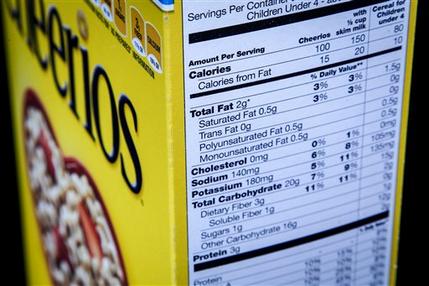WASHINGTON (AP) — After 20 years, the nutrition facts label on the back of food packages is getting a makeover.

Knowledge about nutrition has evolved since the early 1990s, and the Food and Drug Administration says the labels need to reflect that.
Nutritionists and other health experts have their own wish list for label changes.
The number of calories should be more prominent, they say, and the amount of added sugar and percentage of whole wheat in the food should be included. They also want more clarity on serving sizes.
There’s a feeling that nutrition labels haven’t been as effective as they should be, says Michael Jacobson of the Center for Science in the Public Interest. When you look at the label, there are roughly two dozen numbers of substances that people aren’t intuitively familiar with.
For example, he says, most of the nutrients are listed in grams, a basic unit of the metric system. Jacobson says people don’t really understand what a gram is.
Michael Taylor, the FDA’s deputy commissioner for foods, says 20 years ago there was a big focus on fat, and fat undifferentiated. Since then, health providers have focused more on calories and warned people away from saturated and trans fats rather than all fats. Trans fats were separated out on the label in 2006.
The food environment has changed and our dietary guidance has changed, says Taylor, who was at the agency in the early 1990s when the FDA first introduced the label at the behest of Congress. It’s important to keep this updated so what is iconic doesn’t become a relic.
The FDA has sent guidelines for the new labels to the White House, but Taylor would not estimate when they might be released. The FDA has been working on the issue for a decade, he said.
There’s evidence that more people are reading the labels in recent years.
An Agriculture Department study said 42 percent of working adults used the panel always or most of the time in 2009 and 2010, up from 34 percent two years earlier. Older adults were more likely to use it.
The revised label is expected to make the calorie listing more prominent, and Regina Hildwine of the Grocery Manufacturers Association said that could be useful to consumers. Her group represents the nation’s largest food companies.
Hildwine said the FDA also has suggested that it may be appropriate to remove the calories from fat declaration on the label.
It’s not yet clear what other changes the FDA could decide on. Nutrition advocates are hoping the agency adds a line for sugars and syrups that are not naturally occurring in foods and drinks and are added when they are processed or prepared. Now, some sugars are listed separately among the ingredients and some are not.
It may be difficult for the FDA to figure out how to calculate added sugars, however. Food manufacturers are adding naturally occurring sugars to their products so they can label them as natural – but the nutrition content is no different.
Other suggestions from health advocates:
– Add the percentage of whole wheat to the label. Many manufacturers will label products whole wheat when there is really only a small percentage of it in the food.
– Clearer measurements. Jacobson of the CSPI and others have suggested that the FDA use teaspoons, as well as grams, for added sugars.
– Serving sizes that make sense. There’s no easy answer, but health experts say that single-size servings that are clearly meant to be eaten in one sitting will often list two or three servings on the label, making the calorie and other nutrient information deceptive. The FDA said last year that it may add another column to the labels, listing nutrition information per serving and per container. The agency may also adjust recommended serving sizes for some foods.
– Package-front labeling. Beyond the panel on the back, nutrition experts have pushed for labels on the package front for certain nutrients so consumers can see them more easily. The FDA said several years ago it would issue guidelines for front of pack labeling but later said it would hold off to see if the industry created its own labels.
Tracy Fox, a Washington-based nutrition consultant, says clearer information is needed to balance the billions of dollars a year that the food industry spends on food marketing.
There’s a lot of information there, it’s messy, she says. There may be a way to call out certain things and put them in context.
—
Follow Mary Clare Jalonick on Twitter: http://twitter.com/mcjalonick





